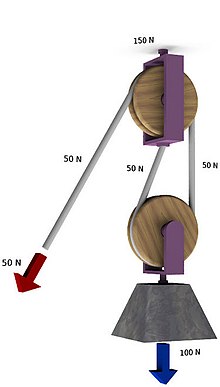Knots/Binding knots/Trucker's hitch
| Trucker's Hitch with Alpine Butterfly Loop | |
|---|---|
 | |
| Category | hitch |
| Typical use | Making a rope very tight, such as to secure an object to a vehicle |
| Caveat | None |
The trucker's hitch, also known as the power cinch, is a self-binding knot commonly used for securing loads on trucks or trailers.
There are several variations of the knot, all of which use a loop in the standing part of the rope as a make-shift pulley in order to theoretically obtain a 3:1 mechanical advantage when used in the typical way as shown. In practice they may only achieve a little more than a 1 to 1 advantage due to friction.
There are unsafe variations of this knot in common use. Because loads falling off of trucks can well cause injuries and deaths, such unsafe versions should not be taught or used. One is the version based on the sheepshank, which can simply fall apart under too little or too much load. Another common variation forms a loop by twisting the rope three times into an eye and pulling the rope through the eye to make a loop; the loop formed in that version is a kind of slipped loop, and the unbalanced load on the loop can cause the loop to be pulled smaller and thereby allow the load to come loose. A reliable version often used is based on the directional figure eight loop. An apparently secure and possibly easier to untie version might be made from a bowline loop, but the end of the rope would need to be available to tie a bowline version.

Tying
[edit | edit source]- Tie an Alpine butterfly loop on the standing end.
- Put the end through the load and then through the loop.
- Pull tight.
- Tie two half hitches, usually slipped for easy releasing, though a more secure finish may be called for. Whatever knot is used to secure the end to the loop, it should be kept in mind that when it is time to untie the knot, the knot will typically still be under load. Many knots are extremely difficult to untie under load. Even a half hitch may be challenging to untie even after the slipped second half hitch is pulled out.
Advantages
[edit | edit source]- Can be tied anywhere in the standing part of the line
- Works like a pair of pulleys, providing up to 3:1 mechanical advantage in tensioning
- Multiple hitches can be cascaded, giving 5:1 (theoretical) and higher mechanical advantage
Mechanical advantage
[edit | edit source]There is often confusion about how much mechanical advantage is provided by the trucker's hitch. For example, when used like in this pulley diagram, such as if the rope above the Trucker's hitch were tied to a rafter in the ceiling, and a weight were being lifted off the floor, the advantage would only 2:1 instead of 3:1. Notice that even though the 100 N force holding up the weight in the diagram is two times the 50 N pull on the end of the rope, the rope from the rafter to the upper pulley must resist both the load weight and the downward pull on the rope end. Thus, the tension in the upper rope would be three times higher than the pull on the rope end. In the more common use of the trucker's hitch, the lower pulley is a hook or ring on the rail of a truck, and the rope across the top of the load has a tension three times the pull on the end. When the end is secured to the loop of the trucker's hitch with a pair of half hitches and let go, the tension in the two segments of rope around the ring will rise 50%, to 75 N each.
